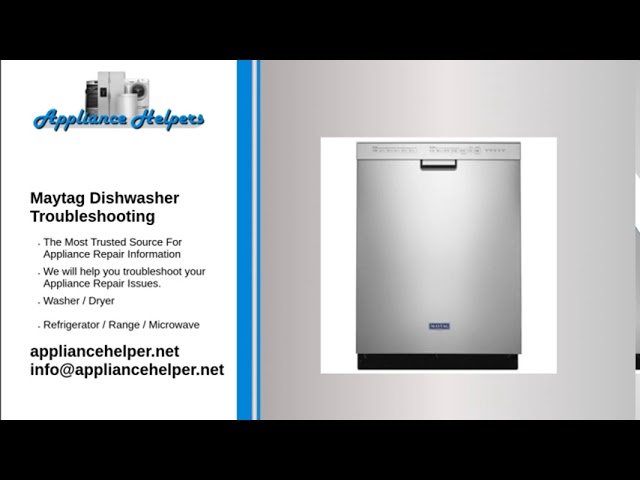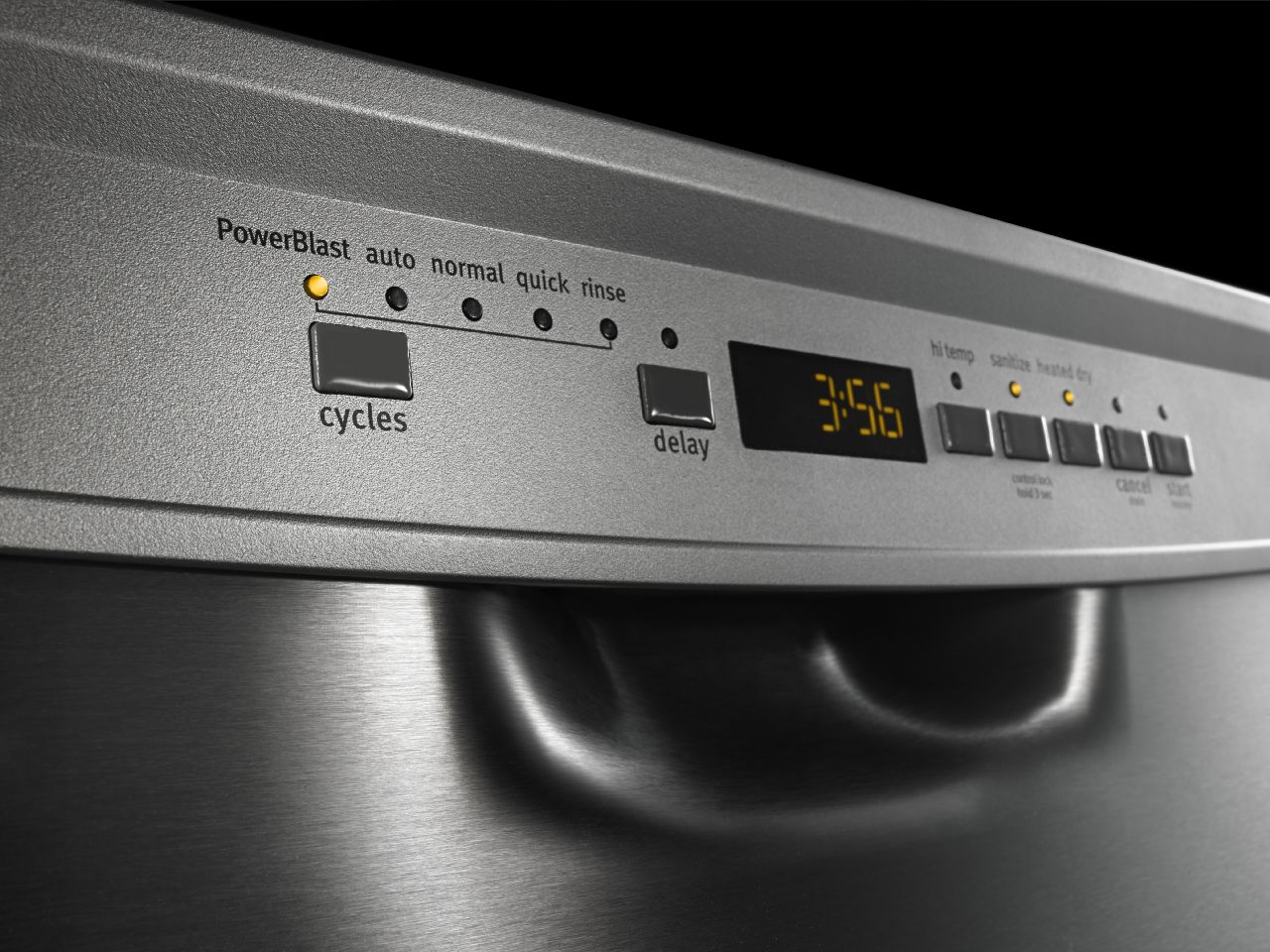
Dealing with a malfunctioning dishwasher can be frustrating. Maytag dishwashers are reliable but can sometimes face issues.
If your Maytag dishwasher isn’t working right, this guide will help. We will cover common problems and simple solutions. Understanding how to troubleshoot your dishwasher can save you time and money. Whether it’s not cleaning well, making strange noises, or not draining, these tips can help.
By knowing what to look for and how to fix it, you can get your dishwasher back in shape. Let’s dive into the common issues and how to solve them.
Dishwasher Not Starting
Struggling with your Maytag dishwasher not starting? Learn simple troubleshooting tips to get it running again. Check power connections and door latch first.
Is your Maytag dishwasher refusing to start? This can be frustrating, especially when dishes are piling up. Let’s walk through some troubleshooting steps to get your dishwasher running again.Check Power Supply
First, ensure your dishwasher is properly plugged in. Sometimes the simplest solutions can be overlooked. Verify if the outlet is working by plugging in another device. Check your home’s circuit breaker. A tripped breaker might be the culprit.Inspect Door Latch
A faulty door latch can prevent your dishwasher from starting. Ensure the door closes securely. Listen for the click when you close the door. This indicates the latch is engaging correctly. If the latch is broken or misaligned, you might need to replace it. This is a common issue that can be fixed relatively easily.Reset Control Panel
Sometimes, the control panel needs a reset. Locate the reset button on your dishwasher, usually found on the control panel. Press and hold the reset button for a few seconds. Release the button and wait for the dishwasher to reboot. This simple step often solves many starting issues. Have you encountered any other problems with your dishwasher? Troubleshooting can seem daunting, but many issues have straightforward fixes. Stay patient and methodical, and you’ll have your Maytag dishwasher up and running in no time.
Credit: fredsappliance.com
Dishes Not Getting Clean
Having dishes come out of the dishwasher still dirty can be incredibly frustrating. If your Maytag dishwasher isn’t cleaning dishes properly, there are several troubleshooting steps you can take to resolve the issue.
Check Spray Arms
One common reason dishes aren’t getting clean is blocked or clogged spray arms. These arms spin and spray water to clean dishes, but if they’re obstructed, water can’t reach all areas.
Inspect the spray arms for debris and clear any blockages. You might be surprised at the amount of food particles that get stuck. Make sure the arms can spin freely without any hindrance.
Clean Filters
Another important component to check is the filters. Dirty filters can prevent water from flowing properly and reduce cleaning efficiency.
Locate the filters at the bottom of your dishwasher. Remove them and rinse thoroughly under running water. You can use a soft brush to gently scrub away stubborn debris.
Regularly cleaning the filters can significantly improve your dishwasher’s performance.
Use Proper Detergent
Using the right detergent is crucial for achieving clean dishes. Not all detergents are created equal, and using the wrong type can lead to subpar results.
Opt for a high-quality detergent recommended by Maytag. Avoid using too much detergent as it can cause residue build-up. Conversely, using too little won’t clean effectively.
Experiment with different brands and types if you’re unsure, and observe the results to find the best fit for your dishwasher.
Have you ever dealt with dirty dishes even after running the dishwasher? How did you solve the problem? Share your tips in the comments below!
Dishwasher Not Draining
Experiencing issues with your Maytag dishwasher not draining? Ensure the drain hose is free from obstructions and check the filter for debris. Simple troubleshooting steps can often resolve draining problems.
If your Maytag dishwasher isn’t draining, it can be a frustrating experience. A dishwasher full of standing water is not only inconvenient but also a potential breeding ground for bacteria. But don’t worry, you can troubleshoot and fix most drainage problems yourself. Here’s how to get started.Clear Drain Hose
First, check the drain hose. It’s the tube that connects your dishwasher to the garbage disposal or sink drain. Over time, this hose can become clogged with food particles and debris. Disconnect the hose and inspect it for any blockages. Use a long flexible brush to clear it out. If the hose looks damaged, replace it to ensure proper drainage.Check Garbage Disposal
If your dishwasher is connected to a garbage disposal, that might be the problem. Sometimes, the disposal can get clogged or the knockout plug wasn’t removed when the dishwasher was installed. Turn off the power and water supply. Check inside the disposal for any blockages. Remove them carefully. Ensure the knockout plug is removed if the dishwasher is newly installed.Inspect Drain Pump
Lastly, the issue could be with the drain pump. The pump pushes water out of the dishwasher and into the drain line. If it’s malfunctioning, water will remain in the dishwasher. Locate the drain pump, usually at the bottom of the dishwasher. Look for any obstructions. If the pump appears damaged or not working, it might need to be replaced. This step can be a bit tricky, so you might want to consult your user manual or call a professional. These simple steps can save you a lot of hassle. Have you ever fixed a draining problem yourself? Share your experience in the comments!Unusual Noises
Is your Maytag dishwasher making strange sounds? Unusual noises can be alarming. They might indicate a problem that needs attention. Let’s explore common causes of these noises.
Inspect Spray Arms
Start by inspecting the spray arms. They might be hitting something. Open the dishwasher and check if the arms move freely. If they are blocked, clear any obstructions. Ensure they spin without resistance. Sometimes, food particles can clog the spray arms.
Check For Loose Items
Loose items can create unusual noises. Look for any dishes or utensils that might be loose. Ensure all items are securely placed in the racks. If you find any loose parts, secure them properly. Loose items can cause rattling sounds.
Examine Motor And Pump
The motor and pump are crucial components. Unusual noises might come from these parts. Listen closely to identify the source. If the motor is loud, it might need professional help. The pump could also be the issue. Ensure there are no blockages in the pump area.
Water Leaks
Water leaks can be a major issue with your Maytag dishwasher. They not only create a mess but can also damage your kitchen floor. Let’s dive into some practical steps to troubleshoot and fix those leaks.
Inspect Door Seal
The door seal is the first thing you should check. It prevents water from leaking out during the wash cycle. Over time, the seal can wear out or get damaged.
Open your dishwasher door and inspect the rubber gasket around the perimeter. Look for any cracks, tears, or signs of wear. If you find any, it’s time to replace the seal. This is a simple fix that can save you a lot of trouble.
Keep the door clean as well. Debris can prevent the door from sealing properly. Wipe it down regularly to ensure a tight seal every time.
Check Water Inlet Valve
The water inlet valve controls the flow of water into your dishwasher. If it’s faulty, water can leak even when the dishwasher is off.
Disconnect the dishwasher from power and water supply before checking the valve. Remove the lower access panel and locate the valve. Inspect it for any signs of damage or corrosion.
If the valve is defective, you will need to replace it. This might seem daunting, but with a little patience and the right tools, you can do it yourself.
Examine Float Switch
The float switch ensures the dishwasher doesn’t overfill with water. If it’s stuck or malfunctioning, it can cause leaks.
Locate the float inside the dishwasher. It’s usually a small, round device at the bottom of the tub. Check if it moves freely up and down. If it’s stuck, clean it to remove any debris.
If cleaning doesn’t help, the float switch may need replacement. Consult your dishwasher’s manual for specific instructions. A functioning float switch is crucial for preventing water overflow.
Have you ever encountered a water leak with your Maytag dishwasher? How did you resolve it? Share your tips and experiences in the comments below!

Credit: www.maytag.com
Error Codes
Maytag dishwashers are reliable appliances, but they can show error codes. These codes help identify specific issues. Understanding these codes can save you time and frustration.
Common Error Codes
Maytag dishwashers display various error codes. Here are some common ones:
- F1: Indicates a heating issue. The water may not be heating properly.
- F2: Points to a drain problem. The dishwasher might not be draining water.
- F3: Shows a water supply issue. Check if water is entering the dishwasher.
- F4: Signals a motor problem. The motor might be malfunctioning.
How To Reset Error Codes
Resetting error codes can sometimes resolve the issue. Follow these steps:
- Turn off the dishwasher.
- Unplug the dishwasher from the power source.
- Wait for about 10 minutes.
- Plug the dishwasher back in.
- Turn the dishwasher on.
If the error code persists, further troubleshooting may be needed.
When To Call A Professional
Some issues require professional help. Call a technician if:
- Error codes continue after resetting.
- You hear unusual noises from the dishwasher.
- There are leaks or water damage.
- You notice electrical issues.
Professionals have the tools and expertise to fix complex problems.
Maintenance Tips
Maintaining your Maytag dishwasher properly ensures it runs efficiently and lasts longer. Regular maintenance prevents common problems and keeps your appliance in top condition. Follow these simple maintenance tips to keep your dishwasher performing at its best.
Regular Cleaning
Clean your dishwasher monthly to remove food particles, grease, and soap residue. Use a soft brush and mild detergent to scrub the interior, including the door seals and spray arms. Run a cycle with a dishwasher cleaner to eliminate any remaining grime.
Proper Loading Techniques
Load dishes correctly to ensure they get clean and avoid damage. Place larger items like pots and pans on the bottom rack. Smaller items and delicate dishes should go on the top rack. Avoid overcrowding to allow water and detergent to reach all surfaces.
Routine Inspections
Inspect your dishwasher regularly for signs of wear or damage. Check the spray arms for clogs and ensure they rotate freely. Examine the door seals for cracks or leaks. Look for any unusual noises or performance issues during operation.

Credit: www.youtube.com
Frequently Asked Questions
What Is The Most Common Problem With The Maytag Dishwasher?
The most common problem with Maytag dishwashers is poor draining. This issue often results from clogged filters or drain hoses.
How Do I Put My Maytag Dishwasher In Diagnostic Mode?
To put your Maytag dishwasher in diagnostic mode, press the “Heated Dry” and “Normal” buttons alternately five times within six seconds.
What Are The Most Common Faults With A Dishwasher?
Common dishwasher faults include clogged filters, faulty door seals, malfunctioning spray arms, broken heating elements, and drainage issues.
Why Does My Maytag Dishwasher Not Start?
Your Maytag dishwasher might not start due to a faulty door latch, power issues, or control panel problems. Check connections and ensure the door is securely closed.
Conclusion
Troubleshooting your Maytag dishwasher doesn’t have to be stressful. Use the tips shared to solve common issues. Regular maintenance helps keep your dishwasher running smoothly. Check filters and clean them often. Inspect spray arms for blockages. Always use the right detergent.
Following these steps can save you time and money. For persistent problems, calling a professional may be best. A well-maintained dishwasher lasts longer and performs better. Keep your Maytag dishwasher in top shape with these simple tips. Happy dishwashing!






